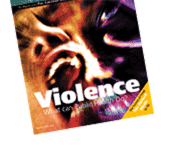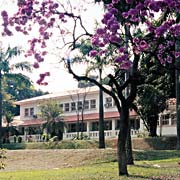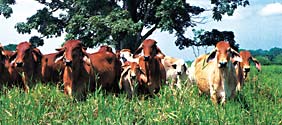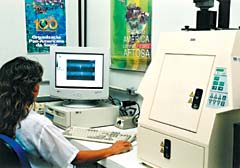
The Magazine of the Pan American Health Organization
Volume 8, Number 3, 2003


PANAFTOSA
Crusaders for Animal Health
by Alexandre Spatuzza

The debilitating and highly contagious disease reached more than 4,000 farms in northern Argentina, northern Uruguay and southern Brazil. More than 20,000 animals were slaughtered to control the outbreak. Thirty-five million dollars' worth of fresh meat exports were cancelled, and millions more in potential sales were lost. Slaughterhouses and packing plants closed down, thousands of workers lost their jobs, and trade was disrupted in several other commodities.
A 2002 report by the Pan American Foot-and-Mouth Disease Center (PANAFTOSA) noted that investments in immunization, surveillance and prevention had declined in the preceding decade after the countries had been declared FMD-free. The lesson, says Eduardo Correa de Melo, PANAFTOSA's director, is that "every country is at risk of the introduction of foot-and-mouth disease as long as it is endemic in other countries where programs have not had the expected results. No country -no matter how isolated-can afford to let down its guard."
Founded in 1951, PANAFTOSA is one of nine specialized centers of the Pan American Health Organization (PAHO). Located in the Brazilian state of Rio de Janeiro, the center works to improve the control and eradication of animal diseases-primarily FMD, but also such threats as rabies, tuberculosis and most recently "mad cow" disease.
In the past 50 years, PANAFTOSA has carried out research on new vaccines and diagnostic procedures, served as a catalyst for technology transfer to its member countries, and trained government and private sector workers throughout the Americas to set up and operate systems for animal disease surveillance and control. Through this work, the center has helped the region's countries develop their potential as meat exporters while also increasing production for domestic consumption.
With PANAFTOSA's help, the region's countries have dramatically reduced the incidence of FMD and are on track to eradicate the disease by 2009. It's a goal that requires not only technical expertise, but political will and international cooperation-along with the involvement of all the region's farmers, down to the smallest farm.

"It must be a joint effort," says Correa. "There must be solidarity with those that face the toughest problems. Animal health is not a problem for one country alone."
Look at a map of South America and Correa's meaning becomes clear. Many of the continent's border areas are remote and undeveloped, making them difficult to monitor.
Chile provides an example. The first South American country to eliminate FMD back in the 1970s, Chile stopped vaccinating against the disease. This earned it the most coveted status in the international meat market, "FMDfree without vaccination," allowing it to ship its meat virtually anywhere in the world. But it also left Chilean livestock with no trace of immunity to the disease.
As a result of contact between Chilean and Argentine livestock grazing in upland pastures near the two countries' border in the summer of 1987, the disease once again broke out. PANAFTOSA consultant José Naranjo was one of 400 veterinarians and technicians who had to search the country for infected and exposed animals, calling the army in to kill and bury them. Nearly 35,000 head of cattle alone were slaughtered to save a national herd of 3.6 million. Thanks to the drastic measures, Chile was able to halt the spread of FMD and was declared disease-free again by December of the same year.
"The positive result of this was a system to control the movement of animals and cooperation agreements with Argentina and Peru," Naranjo says.
Haves and have-notsIntroduced into the Americas from Europe in the 1870s, FMD has at one time affected all of the Western Hemisphere except Central America. Today it remains endemic in Bolivia, Ecuador and Venezuela. All of North America, Central America and the Caribbean are disease-free without vaccination, along with Guyana, Chile and the Argentine Patagonia. Uruguay is "free with vaccination," as are extensive areas of Colombia and Peru. More than 80 percent of Brazil's livestock is in FMD-free zones.
The designation of countries as FMD "haves" and "have-nots" has an enormous impact on trading patterns, with the Paris-based World Organization for Animal Health acting as referee. Known by its French initials, the OIE is responsible for classifying countries according to their foot-and-mouthdisease status. More than 50 of its 162 member countries have been declared FMD-free without vaccination, allowing them to sell their meat products around the world. Those with endemic disease or outbreaks face international bans on their suspect meat. But countries that are FMD-free with vaccination also face a disadvantage in the marketplace, as some countries restrict imports of their meat. While the OIE classification system has ensured transparency and helped protect disease-free countries from importing the virus, it has created a major disincentive for countries to use vaccination as a means of preventing the disease.

OIE rules were modified somewhat in the last decade to allow for FMD-free zones within affected countries, a change that favored Argentina, Brazil and Colombia, among others. Then last year, the organization adopted more profound changes that could have farreaching results. For the first time, it recognized the concept of infection by the FMD virus, as distinct from the presence of antibodies as a result of vaccination. It also reduced from two years to 18 months the time it takes for countries to regain FMD-free status after vaccinating but not sacrificing animals during an outbreak.
"These are positive developments," says Albino Belotto, head of PAHO's veterinary public health program in Washington, D.C. "In the past, stamping out without vaccination was the only way to assure rapid resumption of trade. Now countries can use emergency vaccination without sacrificing vaccinated animals, and then prove that the virus is not in circulation."
The changes were made possible by recent scientific and technological breakthroughs, chief among them a new diagnostic system developed by PANAFTOSA. The system can detect antibodies to the FMD virus, distinguishing infected animals from those that have merely been vaccinated. The OIE has proposed that PANAFTOSA's diagnostic system be adopted as the standard "reference test" for the Americas.
The system, available since 1991, provides a major boost for FMD surveillance efforts, according to PANAFTOSA laboratory coordinator Ingrid Bergmann.
"It is not a disease-control tool as such, but it is a major help in managing vaccinated herds, gaining international recognition as being FMD-free, and guaranteeing domestic and international trade in meat products," Bergmann says.
An equally important PANAFTOSA contribution to the fight against FMD was its development in the early 1980s of a new oil-adjuvant vaccine, a true "disease-control tool" that confers longer-lasting immunity on animals, thus requiring less frequent vaccination than conventional vaccine.
"Earlier vaccines gave animals immunity for a maximum of four months," explains Bergmann. "That meant vaccinating three times a year, with the associated costs of rounding up animals and giving the shots. The oil-adjuvant vaccine is given twice during an animal's first year and only once a year thereafter."
Perhaps PANAFTOSA's most important and enduring contribution was its leadership in developing the 1987 Hemispheric Plan for Foot-And-Mouth Disease Eradication. This continent-wide effort built on the center's work helping countries create national FMD-control programs in the 1960s and 1970s. It followed the establishment in 1973 of the South American Commission for the Fight Against Foot-and-Mouth Disease (COSALFA), set up to coordinate international action. Through this and other multilateral forums, PANAFTOSA helped the region's countries organize their fight against FMD.
The results have been encouraging: FMD control programs were expanded from covering just 30 percent of the region's herds in the 1960s to some 85-90 percent of herds by the 1980s.
Chile, declared FMD-free without vaccination in 1981, became the first success story for these efforts. With PANAFTOSA's support, the country set up a complete surveillance and control system involving both the private and public sectors. The government formed inspection teams, established international cooperation accords and provided mechanisms to cover farmers' eventual losses. Meanwhile cattle ranchers invested even more to train personnel and buy vaccines and related equipment.
The results have been sustained growth in both foreign exports and domestic production.
"Not only are meat and dairy exports to more sophisticated markets growing, but domestic Chilean meat consumption has doubled in the last two decades," says José Naranjo. "PANAFTOSA had a vital role in this by transferring technology, training personnel and helping to create inspection teams."
Eyeing the benefits of dollar-denominated income in new markets, Brazilian farmers began organizing themselves in the 1980s.
"The national livestock council was created in 1982 and wanted to organize the whole meat production chain," explains João Meirelles, a Brazilian cattle rancher and former president of one of the country's cattle growers' associations. "This brought the country from being a net importer of meat in 1978 to being the largest exporter in the world in 2003."
While FMD is still present in some parts of Brazil, proponents of eradication believe their goal is well within reach. "It's becoming easier to do my job," says Dercio Gottardo, a veterinarian in São Paulo state's animal health department. "People are aware of the problem of FMD."
Yet challenges remain. Countries throughout the region face the common problem of "leaky borders," with most governments lacking the manpower to eradicate livestock smuggling. Universal tagging, which allows meat to be traced back to its animal and farm of origin, would help address this and other problems of disease control.
In a May 2003 meeting in Chile, COSALFA called on PANAFTOSA to begin supplying diagnostic kits for FMD surveillance, while seeking an outside partner capable of longerterm, larger-scale production. It also increased PANAFTOSA's power to "audit" countries' FMD status and called on the center to develop a new program to train technicians in monitoring animal health.
In March 2004, at the annual Houston Livestock Show and Rodeo in Texas, PAHO and the U.S. Department of Agriculture will host a Hemispheric Conference on the Eradication of FMD. The meeting is intended to galvanize wide, coordinated international action for the final push to eradicate the disease. A point of emphasis will be the need to further strengthen prevention efforts based on surveillance and quarantine, along with vaccination.
João Meirelles notes that the efforts already undertaken in the past halfdecade in Latin America have produced one of the most efficient disease surveillance networks in the world: "With this setup, we can now look at fighting other important animal diseases such as tuberculosis, rabies, brucellosis-and really move toward the ultimate goal, which is to have healthy animals in a healthy continent."
Alexandre Spatuzza is a Brazilian freelance journalist living in São Paulo.